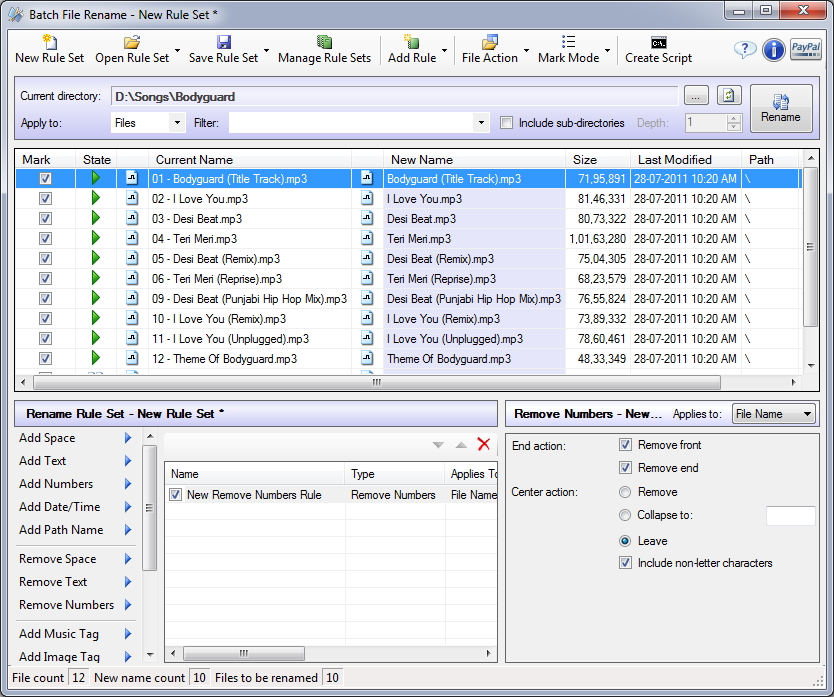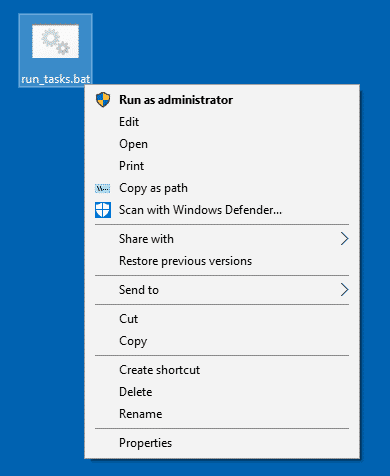- Batch Blog Batch Files Recovery Software
- Batch Blog Batch Files File
- Batch To Batch
- Batch File Variable
In this tutorial, you will learn about batch file functions and how functions are written in batch file programs.
| Batch script functions: Introduction |
| Function definition |
| Function call |
| Basic function example |
| Function with parameters |
| Function with return values |
None of the batch files have return statements. Let us suppose (and this is how the script looks really) the main bat file that back up exec uses in pre command is a.bat a.bat calls other bat files as shown below:-call b.bat call c.bat-These scripts work fine when they are executed from a dos prompt. For loops are available in batch file scripting. This for ioop counts from 9 to 0, incrementing by -1 at each step, and echos the number that the count is currently at. FOR /L%%a IN (9, -1, 0) DO ECHO%%a Variables. Variables in batch files are of the type string (except errorlevel, which is special and of the type byte). This is a blog of Dr.Batcher's development team. Dr.Batcher is the batch files creation and editing software providing you with the simplest way to create and edit batch files. So here you can find information on batch scripting techniques and development of Dr.Batcher. Batch file: A batch file is a text file that contains a sequence of commands for a computer operating system. It's called a batch file because it batches (bundles or packages) into a single file a set of commands that would otherwise have to be presented to the system interactively from a keyboard one at a time. A batch file is usually.
Batch file functions: Introduction
A function is a single comprehensive unit (self-contained block) containing a block of code that performs a specific task. The function performs the same task when called which avoids the need of rewriting the same code again and again.
Like in any other programming language, batch file functions also have:
- function definition
- function call
NOTE: When defining the main program is to ensure that the statement EXIT /B %ERRORLEVEL% is used in the main program to separate the code of the main program from the function.

Batch File Function Definition
-Syntax

As shown in syntax, a function definition in batch file starts with the declaration of a function with a label. Next is the body of function where we write codes to achieve a certain task. At the end EXIT /B 0 is to ensure successful termination or proper exit of the functions.
Batch File Functions Call
Like in every other programming language, to use the defined functions, we need to call it in the main program. For this, CALL command is used.

Batch Blog Batch Files Recovery Software
-Syntax
So, this is how the function is called in batch files.
In the case of batch file functions with parameters, a tilde(~) sign is used to access them in the main program along with the positional number of parameter.
Similarly, in the case of batch file functions with return values, return values are set in the function using the set command and the tilde(~) character along with the positional number of the return values.
Here is the batch file program to demonstrate the use of the basic function, function with parameters and function with return values.
Batch file function example: Program with basic function
Output
Note that the EXIT /B %ERRORLEVEL% is used to separate the function from the main program and PAUSE is used to hold the screen, else output console will vanish within nanoseconds.
Batch file function example: Program demonstrating function with parameters
Output
Here tilde(~) sign is used to access the parameter’s value followed by the position of the parameter. Hence, ~1 is for accessing first parameter and ~2 for the second.
Batch Blog Batch Files File
Batch file function example: Program demonstrating function with return values
Output
Here SET command along with tilde(~) sign is used to set the return values depending on the position followed by tilde sign.
I believe Batch files were available when the first IBM PC hit the market around 1980. They have evolved a little. Batch commands have changed to handle more options, a little more versatility has been added here and there. How come, after 28 years they are still around, and they don’t seem to be going away any time soon? Well, if the task to be performed is not large enough to write code in a compiled language, and not simple enough to do it manually, the batch file is the right answer! It’s fast to write, easy to understand (well, not always), and easy to change. They do have an expensive aspect, though. They are hard to tune up and get running right. A simple mistake can be very hard to find and correct: misspelling a label can result in the wrong execution path; a space in an assignment will result in the wrong assignment, a space in a file name can change execution fatally if the code is not solid. Yes, but with all their frailties and difficulties, we continue to use them.
So who uses batch files? Home users? maybe here and there for some repetitive tasks. But the main users are large companies. They are used in backup processes, in file purging processes, program installations (before setup.exe is ready for prime time), changing user permissions, preparing machines for special code runs, copying data, etc.
Well, batch files can do many things, and be very powerful. Some batch files have thousands of lines of code. They can handle easily jobs which are more cumbersome in other languages, like starting and stopping services.
Power Clock is an innovative Employee Time clock, Job Costing, and Production tracking program. It replaces the outdated mechanical time clock used in many businesses. Easy to use interface that looks like a traditional mechanical time clock. Power Clock is easy. The Power Clock infrared barcode scanner allows employees to clock in and out using specially coded cards. It can connect to remote sites via the internet or any TCP or IP network. With the help of Capterra, learn about Power Clock, its features, pricing information, popular comparisons to other Time Clock products and more. Still not sure about Power Clock? Check out alternatives and read real reviews from real users. Power clock software homeschool. Power Clock is an innovative Employee Time clock, Job Costing, and Production tracking program. It easily replaces the outdated mechanical time clock used in many businesses. Among Power Clock's powerful features are the following. Easy to use and familiar interface that looks like a traditional time clock.
I will write about different aspects of batch files. Today, writing batch files is easier with the introduction of a very cool product: Running Steps. It’s a full featured debugger and code analyzer for batch files. It can cut your development time significantly. It will tell you about your mistakes before you need to dig into your code to find them because something is not executing right. The code analyzer will check your code as you type. It’s a syntax check, even though it goes beyond syntax. Let’s say, I have been programming in C# or C++ all day, and move on to change a batch file. I type the following line:
set MyVariable = new value
Looks fine at first sight, right? Weill, it’s not. Running Steps will display a wiggly line after the variable name. Both the variable name and the value have a space which may not be intended to be there. The variable name is ‘MyVariable ‘ (with a space at the end). Catching this type of issues during execution is a pain. The simpler the mistake, the harder it is to catch.
That is why having a tool to debug batch files is awesome. It will help identify problems before they execute. Running Steps will also allow me to step through my code, set breakpoints, watch/edit variable names, etc. Just what you would expect from a good debugger.
So, I invite you to check it out. You can find it at http://www.steppingsoftware.com . I will be writing more about batch files, common faults, cool programming practices (check some cool information in the ‘Batch File Coding’ forum Stepping Software has created), use of variables, common pitfalls, etc.
I guess this is a good starting point for a blog on Batch Files. Eventually cool tricks and techniques will be all found here.
Batch To Batch
Enjoy!
Batch File Variable
GISkier
